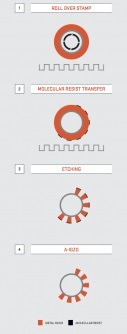Nov 13 2018
Two researchers from the Oregon State University College of Engineering have made a new breakthrough in nanotechnology that could make the lives of diabetic patients less complicated in the near future.
 echnology combines glucose monitoring with an insulin pump to act as an artificial pancreas. Shown here are the steps fabricating the glucose biosensor (a-IGZO-FET) onto a catheter using microcontact printing. The process is repeated three times to form a metal oxide layer. (Image credit: Oregon State University College of Engineering)
echnology combines glucose monitoring with an insulin pump to act as an artificial pancreas. Shown here are the steps fabricating the glucose biosensor (a-IGZO-FET) onto a catheter using microcontact printing. The process is repeated three times to form a metal oxide layer. (Image credit: Oregon State University College of Engineering)
For the three million people living with type 1 diabetes in the United States, hormone therapy and glucose monitoring are everyday challenges that never go away. Type 1 diabetes is also referred to as juvenile diabetes because it is usually diagnosed in youth. It is an autoimmune disorder, wherein the body attacks its own pancreas with antibodies. Type 1 diabetes is responsible for approximately 5% of the diabetic population; each year, about 30,000 new cases are diagnosed.
Along with postdoctoral fellow Xiaosong Du, Greg Herman, professor of chemical engineering, has created a method for printing transistor-based glucose sensors directly onto a catheter fixed to a wearable pump. The pump can be programmed by diabetic patients to deliver glucagon and insulin, the hormones required to regulate blood sugar levels.
The large abdominal gland—pancreas—regulates the blood sugar level and allows the body to obtain energy from food. Coupled with the pump, the sensor-equipped catheter behaves as an artificial pancreas.
The concept is that the integrated electronics of the catheter will not only monitor the blood sugar levels of the patient but will also relay that data to a computerized pump, making sure that diabetic patients receive their glucagon and insulin whenever they need it.
Many of the type 1 diabetes patients in the U.S. are already wearing an insulin pump, so adding glucose sensing to the catheter would greatly simplify their lives.
Greg Herman, Professor of Chemical Engineering, Oregon State University College of Engineering.
Du and Herman achieved the breakthrough by creating transparent biosensors and transistors onto the tight curves of a small glass tube—a step that paves the way for more improved medical diagnostic methods: completely transparent electronics coupled with imaging and sensing technologies.
Earlier, the duo created amperometric glucose sensors onto a flat polymer film, which was subsequently enclosed around a catheter tube. However, when the researchers tested the sensors in an animal model, the devices appeared to delaminate—either the film would separate from the catheter or the sensors would separate from the film.
Earlier, a similar study was performed in which Herman’s collaborators successfully enhanced the robustness of these amperometric sensors. However, in that analysis, Du and Herman tackled the issue by microcontact printing an amorphous indium gallium zinc oxide, field-effect transistor (a-IGZO-FET) directly onto glass tubes that had a 1-millimeter radius.
Herman observed that standard patterning technologies like e-beam lithography and photolithography were shown to be rather complicated for highly curved surfaces; however, microcontact printing appeared to work just as effectively as the team expected.
The process takes advantage of an elastomeric stamp’s ability to conform to curved substrates with minimal distortion of the printed pattern. The adhesion of the deposited films to the glass tube is very good.
Greg Herman, Professor of Chemical Engineering, Oregon State University College of Engineering.
How good was the adhesion? Well, sufficiently good to tolerate all except for the most aggressive intent to eliminate it.
“For the sensor to come off, you’d essentially have to take a file to it,” said Herman. “It’s much more rugged than what we had before, and the electronic performance is excellent — it’s the same as when fabricated on a flat surface using non-printing methods.”
Catheters are either plastic or metallic, and hence unlike the sensor-integrated, glucose-sensing contact lens that was also worked on by Herman, transparency is not actually needed. However, the team utilized a glass tube anyway, partly to show off the transparency of the device.
The idea is that we could start integrating optical fibers that have a-IGZO-FET sensors fabricated directly on them. Some types of sensing need an optical response for detection, so if we can integrate an optical response with an electronic signal, we can expand the detection to other biomarkers. Field effect sensing may increase the functionality and sensing range of optical sensing systems.
Greg Herman, Professor of Chemical Engineering, Oregon State University College of Engineering.
In this manner, it is possible to meld the transparent field-effect sensing with neural imaging and electrophysical devices which could considerably enhance the sensitivity of an endoscope— an instrument inserted into the body to obtain an internal view.
The National Science Foundation and the Juvenile Diabetes Research Foundation supported the researchers’ study for fabricating sensors on curved surfaces. Herman and Du’s study findings have been published in the September 2018 issue of Sensors and Actuators B: Chemical.